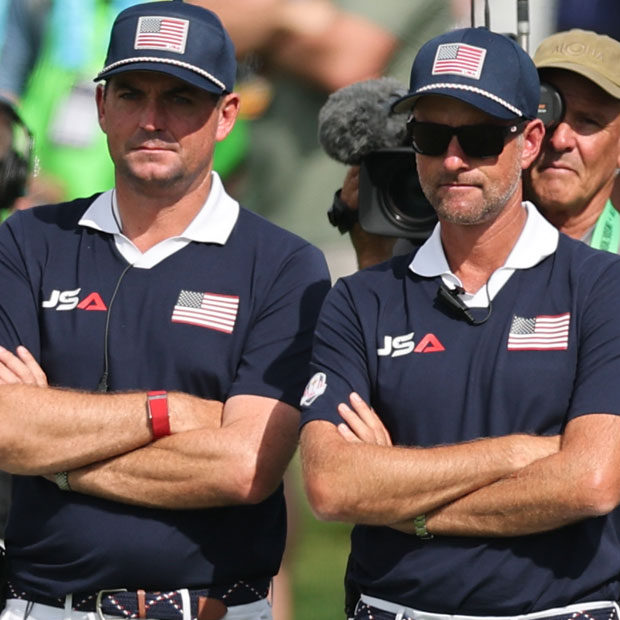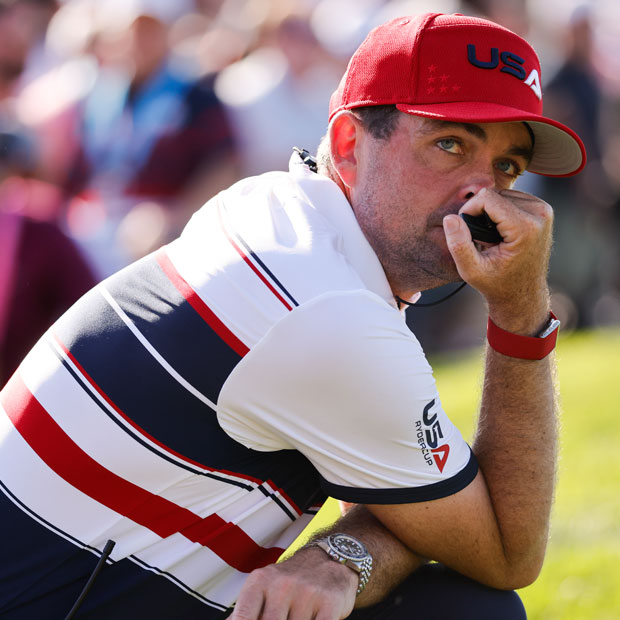Riviera Country Club
While some of George Thomas and Billy Bell’s work has been lost in recent decades, Riviera remains one of the most fascinating examples of Golden Age golf architecture

Los Angeles, California, USA
George Thomas and Billy Bell (original design, 1927); Coore & Crenshaw (greens restoration, 1993); Tom Fazio (various renovation projects, 1999-2012)
Private
$$$$
Riviera’s Weaknesses
Geoff Ogilvy - Riviera, Slow Play, and Adapting to Modern Equipment
In 1925, the Los Angeles Athletic Club set out to create a first-rate golf course on what were then the outskirts of the city. LAAC struck a deal with oil baron Alphonzo Bell to purchase a 290-acre property in and around the Santa Monica Canyon and engaged local golf architect George Thomas. Thomas insisted that his associate Billy Bell be brought on as construction superintendent, and starting in January 1926, the pair transformed the flattish floor and sheer sides of the canyon into a stunning course. They took advantage of the site’s natural features—which included a smattering of sycamores and a dry wash that has evolved over time into a barranca—but also spared no expense in manufacturing fairways, greens, and hazards. Their budget of $243,827.63 was an immense sum for the time. While the brilliance of Thomas and Bell’s work has since been dulled by influences both natural (the flood of 1938) and manmade (the neglect of many architectural nuances, the over-planting of eucalyptus trees), The Riviera Country Club, as it was rechristened early in its history, remains one of the most fascinating examples of Golden Age golf course design.
{{content-block-course-profile-riviera-country-club-001}}
Take Note…
Catbird seats. So you’re going to the Genesis Invitational and would rather not spend the entire tournament walking. Where should you post up? Fried Egg Golf’s Cameron Hurdus recommends the area around the 16th green, where you can watch action not only on 16, an attractive and exacting par 3, but also on a pair of all-world par 4s (5 and 7) and one of the most famous par 3s in the world (the donut-green sixth). Another neat spot is the rise behind the second green—which provides views of the 10th tee, the third tee, and the 18th green—but be warned that it’s often congested during the event.
How could ya, kikuyu? Kikuyu—the sticky, spongy grass that dominates the fairways, roughs, and green surrounds at Riviera—was not originally found on the site. An oft-repeated theory holds that it was tracked in by horses at the neighboring polo fields during the 1932 Olympics. The more likely case is that Riviera’s staff introduced the deep-rooted turf to stabilize damaged sections of the golf course after severe flooding in 1938. In any case, kikuyu is so tenacious that eradicating it from the property would probably be impossible.
The Mashie Course. Along with the championship course, Thomas and Billy supplied Riviera with a “Mashie Course”—that is, a par-3 or pitch-and-putt course—on the site of today’s driving range. The course featured nine holes ranging from 40 to 100 yards and was heavily bunkered. “There is nothing easy about this test,” Thomas wrote of the design; “in fact, great skill will be required to score an average of 3 per hole or 27 strokes for the round.” The course was abandoned in 1943 as a cost-cutting measure during World War II. However, the basic earthworks stayed in the ground until a little over a decade ago, when the PGA Tour requested that the driving range be graded flat. Thanks, Ponte Vedra!
Beef. Speaking of the Mashie Course, Thomas’s contemporary Alister MacKenzie was not a fan. “I recently played over an approach and putt course in Los Angeles which was said to have been laid out by an architect who had written a book on golf, a statement which I can hardly believe,” MacKenzie wrote witheringly in the manuscript that would eventually be published as The Spirit of St. Andrews. “Almost every hole was a monotonous pitch on to a small green completely surrounded by bunkers. Can one imagine anything more dull and uninteresting? The good players would soon tire of playing the same shot time after time, while on the other hand the course was impossible for the average golfer.” Why was he so hard on Thomas? Geoff Shackelford’s theory, which he outlined toward the end of this podcast episode, is that when MacKenzie visited the Riviera site before construction, he must have been under the impression that he had been hired as architect. Of course, George Thomas already had the job, and MacKenzie seems to have nurtured a grudge from that point on.
Favorite Hole
No. 7, par 4, 314-408 yards
The design of this par 4 is so simple and smart that it almost feels like a template—something golf architects could re-create on other sites. There are three primary strategic elements: 1) a barranca running along the right side, on a slight left-to-right diagonal in relation to the tee boxes; 2) a large, visually intimidating bunker cutting in from the left side, on a sharper diagonal; and 3) a small green, pressed against the barranca and protected by run-offs short and left.
Favorite Hole
No. 7, par 4, 314-408 yards
The design of this par 4 is so simple and smart that it almost feels like a template—something golf architects could re-create on other sites. There are three primary strategic elements: 1) a barranca running along the right side, on a slight left-to-right diagonal in relation to the tee boxes; 2) a large, visually intimidating bunker cutting in from the left side, on a sharper diagonal; and 3) a small green, pressed against the barranca and protected by run-offs short and left.
Off the tee, you can’t earn a reward without taking on a proportional risk. For the best angle into the green, you have to favor the right side of the fairway, flirting with the barranca. For an approach shorter than 130 yards, you need to challenge the bottleneck between the barranca and the big bunker. The safest tee shot—one that comes to rest short of the left bunker—leaves a 180-yard-plus approach from a poor angle into a tiny, pushed-up green.
The 1938 flood wiped out No. 7 and the other holes in the low-lying sections of the property, and the fairway bunker was not reinstated until the late 1990s. I wish the club would complete the restoration by re-naturalizing the barranca and removing the superfluous trees along the right side of the hole.

{{content-block-course-profile-riviera-country-club-002}}
Overall Thoughts
In discussions of the greatest feats of construction in the history of golf architecture, George Thomas and Billy Bell’s work at Riviera rarely comes up. More commonly mentioned are C.B. Macdonald and Seth Raynor’s reclamation of a seaside swamp at The Lido, Tom Fazio’s conversion of desert waste into a parkland oasis at Shadow Creek, or even Thomas and Bell’s own struggle against the Los Angeles foothills at Bel-Air Country Club. Those projects were certainly remarkable, and involved radical, large-scale engineering solutions.
Yet what Thomas and Bell achieved at Riviera was just as impressive in its own way. Not only did they move a great deal of dirt—making heavy use of road scrapers, a new technology at the time—but they also concealed their cuts and fills so well that a first-time visitor would never suspect that the property had been substantially altered. For this reason, Ben Crenshaw once wrote that Riviera “is quite possibly the very finest made golf course in the United States.” I would add that it’s also one of the most expertly tied-in courses I’ve seen.
A good example, often cited by Crenshaw as well as Tom Doak, is the finishing hole. Anyone who has watched the annual PGA Tour event at Riviera will be familiar with the grassy amphitheater below the clubhouse in which the 18th green sits. What’s less known is that this entire setting—which flows so seamlessly into the bluff on the left, the clubhouse behind, and the downslope to the second green and 10th tee on the right—was manufactured. As Thomas revealed in his book Golf Architecture in America, a 20-foot-deep gully once ran along the base of the hill. Thomas and Bell’s crew filled in this watercourse, raised the green site an additional 10 feet, and tied everything in with the surrounding terrain. Today, it’s hard to tell where the built components stop and the preexisting ones start

Thomas and Bell did similarly fine work on the fourth and fifth holes, which both occupy ledges that feel natural when you’re on them. It’s only when you see the earthworks from below that you realize how massive the architects’ intervention was.
{{content-block-course-profile-riviera-country-club-003}}
The result is an ideal blend of maximalism and minimalism. Let me explain what I mean. On the one hand, Thomas and Bell’s ability to sculpt the land allowed them to create excellent golf holes where Mother Nature provided little assistance. The aforementioned fourth and fifth holes, for instance, sit on hillside terrain that would have been ungolfable without earthmoving. So it’s entirely to Thomas and Bell’s credit that the holes are what they are: No. 4, a Redan par 3 with a pair of magnificent bunkers and a kicker slope that sweeps off of the canyon wall; and No. 5, a strategic par 4 that rewards a bold tee shot with a view of the green around a fabricated knob.
On the other hand, the architects’ skill in covering their tracks produces an impression of minimalism—that is, a golf experience that feels like a journey through a piece of land rather than a series of architectural contrivances. Thomas’s routing plays to the strengths of the property, alternating between the sides of the canyon, using every available inch of the barranca, and rarely lingering in the less-eventful middle plain for long. It’s like a film that uses plenty of special effects but hides them so well that the viewer can simply focus on the story. (Shoutout Edgar Wright and David Fincher.)
By all rights, Riviera should be a top-10, even a top-five, course in America. The design is that good. But decades of dubious stewardship have left Thomas and Bell’s design in a depleted state. I could name at least a dozen small issues per hole, but to avoid an overload of negativity, I’ll just identify four broad categories of weaknesses I see in Riviera’s presentation:
1. Grabby turf. Kikuyu is not conducive to the ground-game options that Thomas and Bell built into their green complexes. While the grass likely can’t be removed from the property, the grounds crew could at least re-sod the green surrounds with a faster-running turf type, such as one of the new Bermudagrass hybrids that many courses in California have installed recently. The main problem: the contrasts between kikuyu fairways, Bermuda surrounds, and poa annua greens would look a little funky. The playing characteristics would be better, though, and that’s what matters.
2. Constricted fairways. The absurdly under-scaled first fairway is just the most visible example of Riviera’s ill-conceived mowing lines. Many valid strategic options are now covered in rough. For instance, the third fairway should be about 20 yards wider to the right, allowing players to steer clear of the fairway bunker with the consequence of a difficult angle into the green. The current mowing line forces the aggressive play, effectively making the choice for the golfer.
3. The wrong trees in the wrong spots. Eucalyptus trees—non-indigenous, invasive, and dangerously prone to shedding branches—now dominate much of Riviera’s property. The course would instantly improve if a eucalyptus-specific disease were to strike Pacific Palisades. Just consider how much better (if somewhat more scorable) the 13th hole would be if its fairway ran along the natural barranca on the left instead of through a nondescript tunnel of eucalyptus trees.
4. Domestication of natural landforms. Riviera’s famous dry wash-turned-barranca is a sorry sight these days. Large sections of it are covered in green kikuyu rough, in defiance of its natural scrubby character. The portion that splits the eighth fairway has been over-shaped by Tom Fazio’s firm to the point that it would look more at home at Shadow Creek than it does in a Southern California canyon. This is a fixable problem: just look at what Los Angeles Country Club did with its barrancas in 2010 during Gil Hanse’s restoration.
{{content-block-course-profile-riviera-country-club-004}}
George Thomas and Billy Bell built three masterpieces in Los Angeles in the 1920s: LACC’s North Course, Bel-Air, and Riviera. The first two have earned well-deserved accolades over the past 15 years for recovering elements of their original designs. The third—and, in my opinion, the most brilliant—is stuck in a compromised condition. With each passing year, it looks more like a late-20th-century approximation of a Golden Age golf course rather than the genuine article.
So Riviera has a lot of catching up to do. But I doubt the club’s ownership sees it that way.
2 Eggs
Among America’s 50 or so greatest golf courses, Riviera is one of the best-designed. It’s also one of the worst-presented. That the course is still a joy to play—and to watch be played by the world’s best golfers—is a testament to the sturdiness of George Thomas and Billy Bell’s architecture.
Course Tour

{{content-block-course-profile-riviera-country-club-005}}
Additional Content
A George Thomas Classic: Riviera (article)
“A Few Subtleties of Riviera That Don’t Come Across on TV” (article)
“Riviera’s Weaknesses” (member article)
Leave a comment or start a discussion
Get full access to exclusive benefits from Fried Egg Golf
- Member-only content
- Community discussions forums
- Member-only experiences and early access to events
















Leave a comment or start a discussion
Lorem ipsum dolor sit amet, consectetur adipiscing elit. Suspendisse varius enim in eros elementum tristique. Duis cursus, mi quis viverra ornare, eros dolor interdum nulla, ut commodo diam libero vitae erat. Aenean faucibus nibh et justo cursus id rutrum lorem imperdiet. Nunc ut sem vitae risus tristique posuere. uis cursus, mi quis viverra ornare, eros dolor interdum nulla, ut commodo diam libero vitae erat. Aenean faucibus nibh et justo cursus id rutrum lorem imperdiet. Nunc ut sem vitae risus tristique posuere.